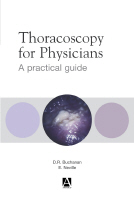Summary:
Thoracoscopy and biopsy have developed as indispensable tools to diagnose
pleural, and sometimes lung, disease when simple clinical and laboratory
methods of examination have failed to yield a diagnosis. Thoracoscopy is most
often undertaken by surgeons, but may also be performed by trained physicians.
It takes place in an endoscopy or operating room using simple sedation, local
anaesthesia and non-disposable equipment, and is a useful, less invasive
alternative to thoracotomy. Direct visualisation of the pleura with the
thoracoscope achieves a diagnosis in approximately 95% of patients with
tuberculosis or malignancy because biopsies are taken from areas seen to be
macroscopically abnormal.
Despite these advantages, the technique has until recently been vastly under-
used in the UK when compared to practice in Europe and North America. This is
now changing, however, with interest in the technique rekindled in parallel
with rapid advances in equipment technology. The time is therefore right for
the publication of this unique clinical guide to thoracoscopic practice. The
book demonstrates the diagnostic and therapeutic value of this technique, which
can be undertaken under local anaesthesia in a district general hospital. In
addition to its use in the diagnosis of pleural disease, thoracoscopy has
valuable therapeutic applications with the concomitant instillation of talc or
other sclerosing agents into the pleural cavity for pleurodesis.
Concise, practical and readable, this volume covers the indications for
thoracoscopic investigation of the thoracic cavity, and describes and
illustrates the techniques involved, their contraindications and associated
hazards. Useful for MRCP candidates and specialist registrars in thoracic
medicine seeking accreditation, it is also a handy aide-memoir for the
practicing respiratory physician.
Potential pitfalls and contraindications clearly indicated
Practical guide covering all aspects of thoracoscopic investigation of the
thoracic cavity for the non-surgeon
Key learning points flagged throughout the text
Table of contents:
1. The undiagnosed pleural effusion
2. Radiology
3. Invasive investigations: percutaneous pleural biopsy
4. Current indications for thoracoscopy
5. Technique of medical thoracoscopy
6. Therapeutic interventions and pleurodesis
7. Thoracoscopy, pleurodesis and post-procedure complications
8. Current practice in video-assisted thoracic surgery
9. Pathological findings
10. Clinical risk assessment: reducing the risks of medical thoracoscopy
Appendix: Equipment
About the Author:
D.R. Buchanan is formerly Specialist Registrar in Respiratory Medicine,
Southampton and Portsmouth Hospitals. UK
E. Neville is Consultant Respiratory Physician, Respiratory Centre, Portsmouth
Hospitals, Portsmouth, UK


